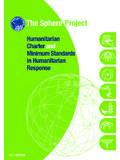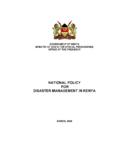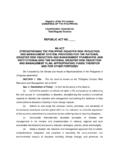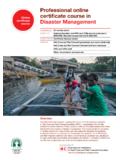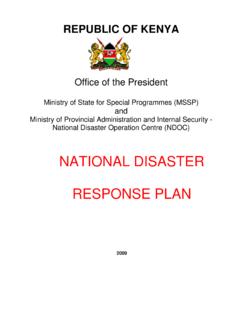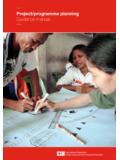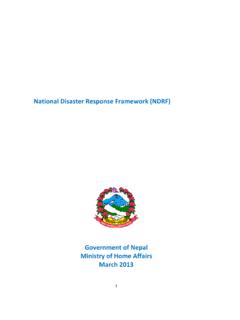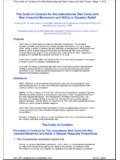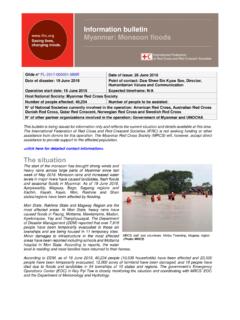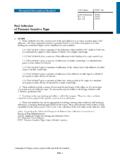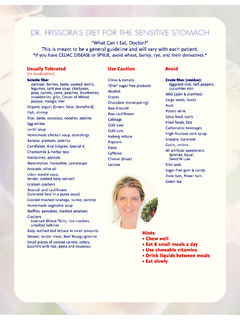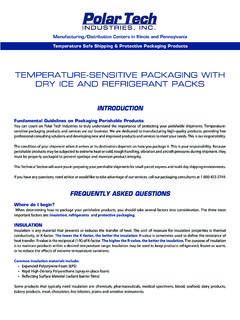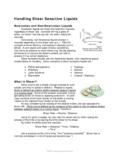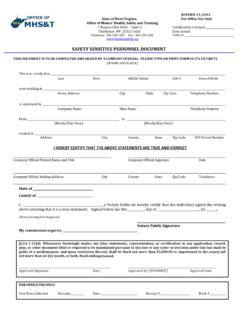Transcription of A practical guide to Gender-sensitive Approaches for ...
1 A practical guide toGender- sensitive Approaches for disaster ManagementStrategy 2020 voices the collective determination of the International Federation of Red Cross and Red Crescent Societies (IFRC) to move forward in tackling the major challenges that confront humanity in the next decade. Informed by the needs and vulnerabilities of the diverse communities with whom we work, as well as the basic rights and freedoms to which all are entitled, this strategy seeks to benefit all who look to Red Cross Red Crescent to help to build a more hu-mane, dignified, and peaceful the next ten years, the collective focus of the IFRC will be on achieving the following strategic aims:1. Save lives, protect livelihoods, and strengthen recovery from disasters and crises2. Enable healthy and safe living3.
2 Promote social inclusion and a culture of non-violence and peaceInternational Federation of Red Cross and Red Crescent Societies, Geneva, 2010. Copies of all or part of this document may be made for non-commercial use, providing the source is acknowledged. The International Federation would appreciate receiving details of its use. Requests for commercial reproduction should be directed to the International Federation at photo:Top left: Conducting Vulnerability and Capacity Assessment in Hubei Province, China to identify and understand disaster risks and community capacities. IFRCL ower left: Tataua of the Tonga Red Cross teaches the women of Funafala Islet to use the emergency satellite phone. September 2007. Giora Dan/IFRCR ight: The Philippine Red Cross volunteers share knowledge and laughter with children at a health and nutrition event in Laguna, Philippines.
3 Rob FewInternational Federation of Red Cross and Red Crescent Box 372 CH-1211 Geneva 19, Switzerland Telephone: +41 22 730 4222 Telefax: +41 22 733 0395 E-mail: Website: Pacific Zone OfficeThe AmpWalk, Suite (North Block) No 218 Jalan Ampang 50450 Kuala Lumpur, Malaysia Tel: +60 3 92075700 Fax: +60 3 21610670 Michael Annear Asia Pacific Head of disaster management Unit Tel: +60 3 92075726 E-mail: Gwynn Asia Pacific Organisational Development CoordinatorTel: +60 3 92705760 Email: practical guide to Gender-sensitive Approaches for disaster management | 1 ContentsSection 1: Purpose and overview 5 Introduction 6 gender Issues in disaster management 7 The approach of The International Federation of Red Cross and Red Crescent Societies 10 Acknowledgements 2 Key definitions 3 Acronyms and symbols 4 Section 2: Integrating gender into the disaster 11 management cycle disaster response 13 disaster recovery 22 disaster preparedness and mitigation 29 Section 3: Strengthening accountability 35 for gender impact Creating enabling environments for gender and diversity in programming 36 Organizational development 41 Monitoring and evaluation for achieving Gender-sensitive programming 45 Section 4: Case studies 48 Overview of case studies 49 Pakistan: Humanitarian Assistance for Internally Displaced Persons 50 Myanmar.
4 Women s Participation in Recovery 55 Bangladesh: Community-Based Flood management Programme 60 China: Community-Based disaster Preparedness 65 Indonesia: Integrated Community-Based Risk Reduction Project 70 Solomon Islands: Working Together for Healthy Communities 75 Reference 812 |AcknowledgementsThe International Federation of Red Cross and Red Crescent Societies would like to thank the Red Cross and Red Crescent Societies of America, Australia, Bangladesh, Canada, Denmark, Fiji, Finland, Indonesia, Nepal, Pakistan, Philippines, Solomon Islands, Sri Lanka, as well as the International Committee of the Red Cross (ICRC) for their participation and contributions at the gender and disaster management Forum which took place in June 2009, kindly hosted by Nepal Red Cross.
5 The Forum provided the inspiration for these Guidelines as well as the source of much of the material contained as best practices in the pages which are also indebted to Ms Cynthia Burton who kindly turned the material from the Forum into the narrative framework for these work is the result of the cooperation between the International Federation of Red Cross and Red Crescent Societies s global Principles and Values Department, and its Asia Pacific Zone disaster management and Organisational Development Units guidelines are a tribute to the women and men who have worked hard in the most challenging humanitarian environments possible, whether as people affected by disasters or as contributors to improving the lives of others, to ensure that gender equal-ity and diversity have remained at the heart of effective disaster response, recovery and risk reduction 12,000 families throughout the Philippines, who were affected by the typhoons and land-slides in 2006, received building materials and guidance on constructing transitional shelters capable of resisting typhoon-strength winds.
6 IFRCA practical guide to Gender-sensitive Approaches for disaster management | 3 Key definitionsSex: The biological characteristics that define humans as either male or female. These sets of biological characteristics are not always mutually exclusive, as there are some individu-als who possess both male and female characteristics. gender : The socially constructed attributes and opportunities associated with being male and female vary widely from place to place. gender defines social and cultural expectations about what behaviour and activities are allowed, what attributes are valued, and what rights and power one has in the family, community and nation. For example, in one society women may be expected to focus on the family s domestic needs while men engage in the formal paid workforce, whereas in another, both men and women may be expected to contribute to the family s cash income.
7 gender audit/stocktake: An assessment tool and process for organisations to identify how gender issues are included in their work with communities and internal organisational processes (Interaction, 2004). gender equality: Refers to both men and women having the freedom to develop their personal abilities and make choices without the limitations set by stereotypes, rigid gender roles, or prejudices. It does not mean that men and women have to become the same, but that their rights, responsibilities and opportunities should not depend on whether they are born male or female. gender inequality predominantly impacts negatively on women and girls, as men tend to have more decision-making power and control over resources than women. Because of this, efforts to advance gender equality need to focus primarily on improving the situation and status of women and girls in their societies.
8 For example, specific actions may be taken to ensure that women s views and priorities are adequately and directly heard in disaster management equity: Refers to fairness of treatment for women and men according to their respective needs. This may include equal treatment, or treatment that is different but considered equivalent. For example, specific outreach strategies may be developed to ensure that relief assistance reaches female-headed households in societies where the mobility of women is restricted. Likewise, general distribution centres may be created or certain livelihood recovery activities may be designed and implemented specifically by and for : Respect for diversity means not only accepting that others may be different, but also respecting those differences. In its programmes, the International Federation has also specified criteria that may not be used to make an adverse distinction: ethnic origin, nationality, sex, political opinion, philosophy, religious belief, social origin, class, sexual preference, age, disability, physical characteristics and language (COUNCIL OF DELEGATES Seoul, 16 18 November 2005 paper on Promoting respect for diversity, fighting discrimi-nation and intolerance ).
9 Source: Adapted from Enarson (2009) and L Bayaarma (2002) except where indicated otherwise. 4 | International Federation of Red Cross and Red Crescent Societies To guide the reader the following symbols are used: practical action example Must read Tools located on CD Rom Tips or checklist Case study AcronymsALNAP Active Learning Network for Accountability and Performance in Humanitarian ActionAPFWLD Asia Pacific Forum on Women, Law and Development DRR disaster risk reductionFAO Food and Agricultural OrganisationGBV gender -Based Violence HIV/AIDS Human Immuno-Deficiency Virus/Acquired Immunity Deficiency SyndromeIASC Inter-Agency Standing CommitteeIFRC International Federation of Red Cross and Red Crescent Societies ILO International Labour OrganisationNGO Non-Governmental OrganisationRCRC Red Cross Red CrescentUNFPA United Nations Fund for Population ActivitiesUNHCR United Nations High Commission on Refugees VCA Vulnerability and Capacity AssessmentWFP World Food Programme A practical guide to Gender-sensitive Approaches for disaster management | 5 Purpose and overview Introduction gender Issues in disaster management The Approach of The International Federation of Red Cross and Red
10 Crescent SocietiesSection 1 Photo: Korea Volunteer Kim Cheung Sook helps to ensure that emergency supplies remain on hand before disasters strike in Few6 | International Federation of Red Cross and Red Crescent Societies Male and Female disaster preparedness volun-teers from Mongolia Red Cross providing first aid service for victims affected by fire, earthquake and chemical guidelines are intended to help Red Cross and Red Crescent National Societies and the International Federation of Red Cross and Red Crescent Societies (IFRC) incorporate effective Gender-sensitive and inclusive Approaches into their disaster management strategies when assisting communities prepare for, respond to, and recover from the Gender-sensitive and gender -inclusive Approaches referred to throughout these guidelines address the needs of both men and women, greater focus is placed on addressing the needs of women, as it is recognised that women more often carry additional disadvan-tages due to gender than men.
